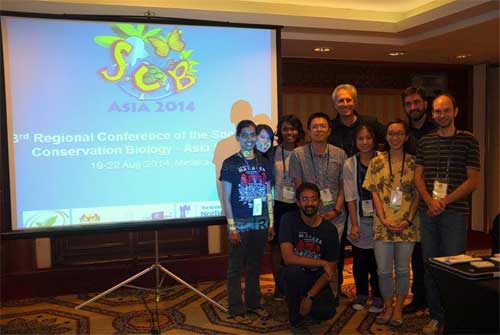The last few decades have seen enormous changes in Asian tropical landscapes and coastal areas and the biodiversity within them. Tropical forests have shrunk on average by 1-2% annually, and mangrove areas have shrunk 3-5 times the rate of terrestrial forests, fuelled by expansion of rice, oil palm and aquaculture. Wilderness areas are now just 20% of their former size and intact primary forests have steadily been eroded and degraded. Small scale fisheries are proliferating without demonstrable increases in catches and increasing reports of destructive fishing practices both cause concerns over coastal resource sustainability.
To compensate for these losses, increasing areas have been set aside in protected areas, especially in developing Asia. Now at least some Asian countries are within reach of their Aichi Targets. However, biodiversity inside these protected areas has come under increasing threat from demand for traditional medicines, and other wildlife products, illicit cross-border trade, itself facilitated by improved transportation infrastructure and affluence. This powerful combination of drivers together with weak policy and management of protected areas, have led to the collapse of turtle, songbird, pangolin, tiger and rhino populations in Asia.
In July 2014, scientists and conservation practitioners from around Asia convened in Melaka, Malaysia for the Society for Conservation Biology – Asia Section’s annual meeting to discuss the current state of biodiversity and the way forward for conservation in tropical Asia. This has culminated in the publication of a set of seminal studies in a Conservation Focus section, edited by us, in the SCB journal Conservation Biology.
 |
|
SCB Asia 2014 Meeting |
The first three studies focus on forests and forested lands. The first study led by Daniel Friess and colleagues considers the policy changes that would be required to enhance conservation of mangrove forests. The study found that protecting and managing remaining mangroves can be done through expansion of marine protected areas to include mangroves, collaboration between the communities and governments, private sector initiatives, and implementation of payments for ecosystem services (PES) at multiple scales. The second study by Roman Carrasco and colleagues identifies five main challenges for reconciling the rapid expansion of oil palm, and other agricultural landuse, and forest ecosystem services, and identify a set of research priorities for overcoming these challenges. In a third study, Jedediah Brodie and colleagues use case studies from Malaysia, Singapore and Bhutan to examine the synergies between science and policy for the implementation of habitat corridors. They found that the scientific prescriptions for habitat connectivity should be synchronized in time with political buy-in and establishment of policies to create optimally designed and configured corridors.
The last two articles focus on conservation of organisms living inside forested landscapes. Studies of wildlife trade mostly focus on cross-border international trade, with few studies of the impact of local hunting and trade. In a fourth study Rhett Harrison and colleagues found that hunting poses the greatest immediate threat to the survival of most of the region’s endangered vertebrates, and is in no place sustainable under the current harvest practices. They recommend several immediate interventions including improved enforcement, efforts to engage hunters in sustainable hunting practices, and the reduction of public demand for bushmeat. In a fifth study, John-James Wilson and colleagues assess the utility of DNA barcodes as an advanced technology for documenting biodiversity.
We believe that multi-disciplinary approaches involving teams of conservation scientists, business leaders, social scientists, activists and policy makers are needed to solve the complex conservation challenges in the Anthropocene.
 |
|
SCB Asia 2014 Meeting |
Antony J. Lynam, Ahimsa Campos-Arceiz, and Lindsay Porter
Links to the articles in the Conservation Focus; The Challenge of Conservation in Changing Tropical Southeast, below
Impacts of hunting on tropical forests in Southeast Asia (pages 972–981)
Application of DNA barcodes in wildlife conservation in Tropical East Asia (pages 982–989)